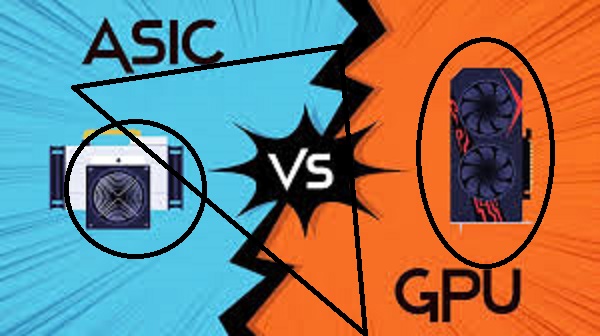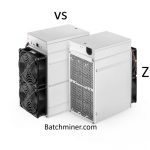
Cryptocurrency mining has revolutionized the digital financial world, with two primary technologies leading the charge: ASICs and GPUs. These tools are pivotal in mining operations, each with distinct strengths and weaknesses. This article dives deep into their differences, helping you decide which suits your mining needs.
What is an ASIC?
An Application-Specific Integrated Circuit (ASIC) is a specialized hardware device designed explicitly for cryptocurrency mining. Unlike general-purpose hardware, ASICs are tailor-made for a single task, such as mining Bitcoin or Litecoin.
- Efficiency: ASICs are highly efficient, delivering unmatched performance for their specific tasks.
- Purpose-built: For instance, a Bitcoin ASIC miner focuses solely on the SHA-256 algorithm, optimizing performance beyond generic devices.
- Compact Design: These devices are often smaller and more energy-efficient than comparable mining setups.
ASIC miners, while powerful, lack flexibility. If the cryptocurrency becomes unprofitable to mine, the ASIC cannot be repurposed for other tasks.
What is a GPU?
A Graphics Processing Unit (GPU), initially designed for rendering graphics, has been widely adopted for mining. Its versatility allows it to mine a variety of cryptocurrencies, making it a favorite for amateur and professional miners alike.
- Adaptability: GPUs can switch between mining different cryptocurrencies, such as Ethereum or Monero.
- Multipurpose Utility: Beyond mining, GPUs excel in gaming, AI development, and data visualization.
- User-friendly: Setting up a GPU mining rig is more accessible and often well-documented.
While versatile, GPUs typically consume more power and have a lower hash rate than ASICs.
ASIC vs GPU: A Comparative Overview
Understanding the key differences between ASICs and GPUs is crucial for making an informed decision.
| Feature | ASIC | GPU |
|---|---|---|
| Purpose | Single-task (e.g., Bitcoin) | Multi-task (e.g., Ethereum, Monero, gaming) |
| Efficiency | High for specific algorithms | Moderate across various tasks |
| Cost | Higher initial cost | Moderate initial cost |
| Flexibility | Limited | High |
| Resale Value | Lower (specific use) | Higher (multi-use potential) |
Performance Comparison
Performance is often a critical factor. ASICs outpace GPUs in hash rates but are narrowly focused on specific algorithms. For instance, an ASIC designed for Bitcoin mining can generate significantly higher yields but won’t work for Ethereum mining. Conversely, GPUs are slower but excel in algorithm versatility.
Energy Efficiency
Energy consumption can make or break mining profitability. ASICs, designed for efficiency, often consume less power per hash compared to GPUs. However, GPUs offer better thermal management, which can be crucial in large-scale operations.
Initial Investment Costs
The upfront cost for ASICs tends to be higher. For example:
- A high-end ASIC miner may cost $5,000–$15,000.
- A comparable GPU rig could range from $3,000–$8,000, depending on the number of cards.
Scalability and Upgradability
Scalability is another key consideration. ASICs, being specialized, cannot be upgraded to support new algorithms. GPUs, however, can adapt by switching to different cryptocurrencies or tasks, making them more future-proof.
Ease of Use and Flexibility
Setting up an ASIC miner is typically more straightforward than configuring a GPU rig. However, GPUs allow greater control, enabling users to mine multiple cryptocurrencies or even perform non-mining tasks.
Longevity and Durability
ASICs are built for endurance but have a fixed lifespan due to rapid advancements in technology. GPUs generally last longer because they can be repurposed after their mining lifecycle ends.
Mining Algorithms
ASICs dominate specific algorithms like SHA-256 and Scrypt, whereas GPUs excel in versatile algorithms such as Ethash and CryptoNight.
Market Trends and Availability
The demand for GPUs often fluctuates with gaming trends, whereas ASICs are tied to cryptocurrency booms. Current market conditions show a rising demand for energy-efficient ASICs, but GPUs remain popular for their adaptability.
Use Cases Beyond Mining
GPUs are clear winners here, with applications in gaming, AI, and more. ASICs, however, have negligible resale value outside mining.
Security and Risks
ASICs can lead to centralization risks, as their use is dominated by large mining farms. GPUs, with their broader accessibility, are less likely to centralize mining power.
FAQs About ASIC vs GPU
1. Which is more profitable: ASIC or GPU mining?
ASICs are generally more profitable but lack flexibility.
2. Can I switch algorithms with an ASIC?
No, ASICs are locked to specific algorithms.
3. Are GPUs better for beginners?
Yes, due to their adaptability and user-friendly setup.
4. What is the lifespan of an ASIC miner?
Typically 2–3 years before becoming outdated.
5. How do GPUs handle updates in mining algorithms?
GPUs are versatile and can adapt to new algorithms with software updates.
6. Which is better for long-term mining?
GPUs offer more longevity and secondary uses.
Conclusion
Both ASICs and GPUs have their merits and drawbacks. ASICs deliver unparalleled efficiency for dedicated tasks, while GPUs shine in versatility and adaptability. Choosing between the two depends on your specific goals, budget, and long-term vision for mining.






